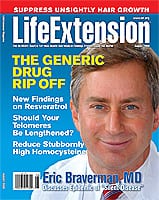 | August 4, 2009 | Resveratrol's anti-inflammatory mechanism defined | | In the August, 2009 issue of The Journal of the Federation of American Societies for Experimental Biology (FASEB Journal), researchers from the University of Singapore and the University of Glasgow in Scotland report their discovery of the mechanism supporting the ability of resveratrol, an antioxidant compound that occurs in red wine, to control acute inflammation. "Strong acute inflammatory diseases such as sepsis are very difficult to treat and many die every day due to lack of treatment," stated study coauthor Alirio Melendez, who is a senior lecturer on the faculty of medicine at Glasgow Biomedical Research Centre. "Moreover, many survivors of sepsis develop a very low quality of life due to the damage that inflammation causes to several internal organs. The ultimate goal of our study was to identify a potential novel therapy to help in the treatment of strong acute inflammatory diseases." The scientists tested the effect of pretreatment with several concentrations of resveratrol in cultured white blood cells known as neutrophils derived from mice and humans to which a proinflammatory agent was administered. "Pretreatment of human and mouse neutrophils with resveratrol significantly blocked oxidative burst, leukocyte [white blood cell] migration, degranulation, and inflammatory cytokine production," the authors report. "The anti-inflammatory action of resveratrol was a function of inhibition of sphingosine kinase activity within 5 minutes of exposure, its membrane location, and sphingosine kinase1-mediated calcium ion release. We also provide evidence that the sphingosine kinase inhibitory effect of resveratrol was mediated via its ability to block phospholipase D activity." In another experiment using mice in which peritonitis was induced with the same proinflammatory agent, pretreatment by injection with resveratrol prevented the strong inflammatory response that was observed in the non-pretreated group. Increases in vascular permeability and neutrophil migration and recruitment were blocked, and levels of proinflammatory cytokines including interleukin-6, interleukin-1B, and tumor necrosis factor-alpha were significantly reduced. The authors suggest an upstream role for sphingosine kinase in the nuclear factor kappa-beta pathway of inflammation. "In light of its pharmacological safety and promising anti-inflammatory activity, resveratrol presents as an attractive compound for phase-1 clinical trials for the assessment of pharmacovigilance, pharmacokinetics and pharmacodynamics in patients with inflammatory conditions," they conclude. "The therapeutic potential of red wine has been bottled up for thousands of years," FASEB Journal Editor-in-Chief Gerald Weissmann, MD observed, "and now that scientists have uncorked its secrets, they find that studies of how resveratrol works can lead to new treatments for life-threatening inflammation." | |  |  | | Trauma is a stressful event caused by either a mechanical or a chemical injury. Depending on its level, trauma can have serious short-term and long-term consequences. The role of healthy nutrition, both in promoting healing and in avoiding complications associated with trauma, has long been acknowledged in trauma recovery. The body needs a certain amount of nutrients to maintain a constant, healthy state. This need is determined by the basal metabolic rate. Any external or internal trauma raises the metabolic rate, and greater amounts of oxygen and nutrients are required to supply enough fuel and amino acids for repair and recovery. Energy expenditure may rise by 10 percent to 50 percent to support the intense metabolic workload (Omerbegovic M et al 2003). Protein and amino acid requirements increase to support formation of new tissues and proliferation of immune cells, maintain lean body mass (or muscle protein), and replace the protein lost to perspiration, bleeding, and excretion. A positive nutritional balance is reflected in rapid healing of wounds, an efficient immune response, the absence of infections or sepsis (shock), and maintenance of a lean body mass. The following vitamins and nutrients may aid the healing process: - Vitamin A—5000 to 10,000 international units (IU) daily
- Vitamin C—1000 milligrams (mg) daily
- Zinc—50 mg daily
- L-arginine—9000 to 18,000 mg daily
- L-ornithine—1000 mg daily
- Glutamine—1000 to 3000 mg daily
- Bromelain—500 mg daily
- Glucosamine —1500 mg daily
- Aloe vera—follow label directions
- Curcumin—800 to 1600 mg daily
- Omega-3 fatty acids—1400 mg EPA and 1000 mg DHA daily
| Life Extension Magazine August, 2009 issue now online 
- On the cover:
- Reports:
- Understanding Risk Factors for Heart Disease, By Dr. William Davis
- Impede Unwanted Hair Growth, by Gary Goldfaden, MD, and Robert Goldfaden
- Is Homocysteine Making You Sick?, by Robert Haas, MS
- Detecting Silent Diseases Before They Strike, Eric Braverman, MD
- Extending Life and Fighting Disease with Resveratrol, by Julius Goepp, MD
- Turning on Immortality: The Debate Over Telomerase Activation, William Andrews, PhD and Michael West, PhD
- Departments:
- Scientific abstracts:
| |  | St John's Wort Extract   | | St. John’s Wort (hypericin extract) is a weak inhibitor of monoamine oxidase (MAO), which may destroy dopamine in the brain and lead to low spirits. It has also been shown to inhibit re-uptake of several neurotransmitters, including serotonin, dopamine, noradrenaline, GABA, and L-glutamate in the brain, and to reduce expression of interleukin-6. Each of these actions can contribute to alleviating low mood status by slowing the recycling of neurotransmitters needed for maintaining emotional balance. Flavonoids, hypericin, and pseudo-hypericin are the constituents thought to be associated with the benefits of St. John’s Wort. | | | Hi-Lignan® Nutri-flax®   | | Lignans are natural phytochemicals. Scientific research has shown lignans to have numerous health benefits for men and women: - High in dietary fiber, containing both soluble and insoluble fiber
- Good source of plant-derived omega-3 fatty acids
- Very low sodium content
- Potassium to sodium ratio of 17:1
- Preserves nature’s balance of electrolytes
| | | |  | | Life Extension Update | | What's Hot | | Life Extension magazine | |
















